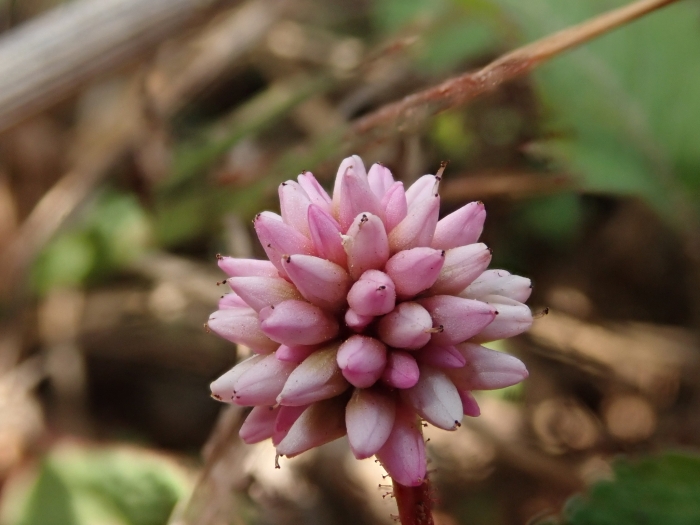Pinkhead Smartweed
(Persicaria capitata)
Pinkhead Smartweed (Persicaria capitata)
/
/

Nolan Exe
CC BY 4.0
Image By:
Nolan Exe
Recorded By:
Copyright:
CC BY 4.0
Copyright Notice:
Photo by: Nolan Exe | License Type: CC BY 4.0 | License URL: http://creativecommons.org/licenses/by/4.0/ | Rights Holder: Nolan Exe | Publisher: iNaturalist | Date Created: 2019-02-24T15:18:38-08:00 |




















































Estimated Native Range
Summary
Persicaria capitata, commonly known as Pinkhead Smartweed, is an evergreen perennial herb native to the Himalayas and Asia often found in open woodlands and along forest edges. This ground-covering plant has a prostrate growth habit, with leaves that are green with distinctive pink to red bands or blotches and are covered in short, scattered hairs. The plant is known for its spikes that are 5–10 mm long and 5–7 mm in diameter, and it emits a strong urine-scented odor. Pinkhead Smartweed produces dense, rounded clusters of pink and red flowers during the spring and summer months, which are highly attractive to pollinators.
In cultivation, Pinkhead Smartweed is valued for its vibrant foliage and flowers, which can add color to garden borders and rockeries. It is also used as a ground cover due to its spreading habit. This plant prefers full sun to part shade and requires medium amounts of water, thriving in soils with medium drainage. While it is relatively low-maintenance, it can become invasive outside its native range, so gardeners should monitor its spread and be aware of local regulations. It is potentially invasive in some regions, including the United States, and should be planted with caution.CC BY-SA 4.0
In cultivation, Pinkhead Smartweed is valued for its vibrant foliage and flowers, which can add color to garden borders and rockeries. It is also used as a ground cover due to its spreading habit. This plant prefers full sun to part shade and requires medium amounts of water, thriving in soils with medium drainage. While it is relatively low-maintenance, it can become invasive outside its native range, so gardeners should monitor its spread and be aware of local regulations. It is potentially invasive in some regions, including the United States, and should be planted with caution.CC BY-SA 4.0
Plant Description
- Plant Type: Herb
- Height: 0.1-0.3 feet
- Width: 0.75-1.5 feet
- Growth Rate: Moderate
- Flower Color: Pink, Red
- Flowering Season: Spring, Summer
- Leaf Retention: Evergreen
Growth Requirements
- Sun: Full Sun, Part Shade
- Water: Medium
- Drainage: Medium
Common Uses
Bee Garden, Bird Garden, Butterfly Garden, Groundcover, Low Maintenance, Rock Garden, Showy Flowers
Natural Habitat
native to the Himalayas and Asia often found in open woodlands and along forest edges
Other Names
Common Names: Pink-Headed Persicaria, Pink Knotweed, Japanese Knotweed, Pink Bubble Persicaria, Kogelduizendknoop, Ampelpilört, Slingerormrot, Slingerpilört, Köpfchen-Knöterich, Nudosilla
Scientific Names: , Persicaria capitata, Polygonum capitatum, Polygonum repens, Cephalophilon capitatum, Truellum capitatum,
GBIF Accepted Name: Persicaria capitata (Buch.-Ham. ex D.Don) H.Gross